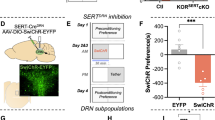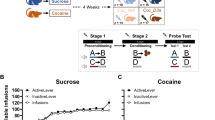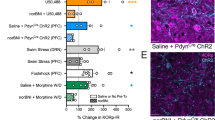Abstract
Repeated forced-swim stress (FSS) produced analgesia, immobility and potentiation of cocaine-conditioned place preference (CPP) in wild-type C57Bl/6 mice, but not in littermates lacking the kappa opioid receptor (KOR) gene. These results were surprising because kappa agonists are known to produce conditioned place aversion and to suppress cocaine-CPP when coadministered with cocaine. The possibility that disruption of the kappa system blocked the stress response by adversely affecting the hypothalamic-pituitary axis was examined by measuring plasma corticosterone levels. However, disruption of the dynorphin/kappa system by gene deletion or receptor antagonism did not reduce the FSS-induced elevation of plasma corticosterone levels. A second explanation for the difference is that kappa receptor activation caused by FSS occurred prior to cocaine conditioning rather than contemporaneously. To test this hypothesis, we measured the effects of the kappa agonist (trans)-3,4-dichloro-N-methyl-N-[2-(1-pyrrolidinyl)-cyclohexyl]benzeneacetamide (U50,488) administered to mice at various intervals preceding cocaine conditioning. The results showed that the interaction between the kappa system and cocaine reinforcement depended on the timing of the drug pairing. Mice given U50,488 60 min prior to cocaine showed a robust, nor-BNI-sensitive potentiation of cocaine-CPP, whereas administration 15 min before cocaine significantly suppressed cocaine-CPP. In the absence of cocaine, U50,488 given 60 min prior to saline conditioning produced no place preference, whereas administration 15 min before saline conditioning produced significant place aversion. The results of this study suggest that kappa receptor activation induced by FSS prior to the cocaine-conditioning session may be both necessary and sufficient for potentiation of the reinforcing actions of cocaine.
Similar content being viewed by others
Log in or create a free account to read this content
Gain free access to this article, as well as selected content from this journal and more on nature.com
or
References
Basbaum AI, Fields HL (1984). Endogenous pain control systems: brainstem spinal pathways and endorphin circuitry. Annu Rev Neurosci 7: 309–338.
Chavkin C, Goldstein A (1981). Specific receptor for the opioid peptide dynorphin: structure-activity relationships. Proc Natl Acad Sci USA 78: 6543–6547.
Covington III HE, Miczek KA (2001). Repeated social-defeat stress, cocaine or morphine. Effects on behavioral sensitization and intravenous cocaine self-administration binges. Psychopharmacology 158: 388–398.
Der-Avakian A, Will MJ, Bland ST, Deak T, Nguyen KT, Schmid MJ et al (2005). Surgical and pharmacological suppression of glucocorticoids prevents the enhancement of morphine conditioned place preference by uncontrollable stress in rats. Psychopharmacology 179: 409–417.
Deroche-Gamonet V, Sillaber I, Aouizerate B, Izawa R, Jaber M, Ghozland S et al (2003). The glucocorticoid receptor as a potential target to reduce cocaine abuse. J Neurosci 23: 4785–4790.
Erb S, Shaham Y, Stewart J (1998). The role of corticotropin-releasing factor and corticosterone in stress- and cocaine-induced relapse to cocaine seeking in rats. J Neurosci 18: 5529–5536.
Haile CN, GrandPre T, Kosten TA (2001). Chronic unpredictable stress, but not chronic predictable stress, enhances the sensitivity to the behavioral effects of cocaine in rats. Psychopharmacology 154: 213–220.
Hotchkiss AK, Pyter LM, Neigh GN, Nelson RJ (2004). Nycthemeral differences in response to restraint stress in CD-1 and C57BL/6 mice. Physiol Bev 80: 441–447.
Hough LB, Nalwalk JW, Chen Y, Schuller A, Zhu Y, Zhang J et al (2000). Improgan, a cimetidine analog, induces morphine-like antinociception in opioid receptor-knockout mice. Brain Res 880: 102–108.
Iyengar S, Kim HS, Wood PL (1986). Kappa opiate agonists modulate the hypothalamic-pituitary-adrenocortical axis in the rat. J Pharmacol Exp Ther 238: 429–436.
Koob GF (2003). Neuroadaptive mechanisms of addiction: studies on the extended amygdala. Eur Neuropsychopharmacol 13: 442–452.
Kumor KM, Haertzen CA, Johnson RE, Kocher T, Jasinski D (1986). Human psychopharmacology of ketocyclazocine as compared with cyclazocine, morphine and placebo. J Pharmacol Exp Ther 238: 960–968.
Kuzmin AV, Gerrits MAFM, Jan M, Van Ree JM (1998). Opioid receptor blockade with nor-binaltorphimine modulates cocaine self-administration in drug-naive rats. Eur J Pharmacol 358: 197–202.
Lê AD, Harding S, Juzytsch W, Watchus J, Shalev U, Shaham Y (2000). The role of corticotrophin-releasing factor in stress-induced relapse to alcohol-seeking behavior in rats. Psychopharmacology 150: 317–324.
Lucki I, Dalvi A, Mayorga AJ (2001). Sensitivity to the effects of pharmacologically selective antidepressants in different strains of mice. Psychopharmacology 155: 315–322.
Mague SD, Pliakas AM, Todtenkopf MS, Tomasiewicz HC, Zhang Y, Stevens Jr WC et al (2003). Antidepressant-like effects of kappa-opioid receptor antagonists in the forced swim test in rats. J Pharmacol Exp Ther 305: 323–330.
Maisonneuve IM, Archer S, Glick SD (1994). U50,488, a kappa opioid receptor agonist, attenuates cocaine-induced increases in extracellular dopamine in the nucleus accumbens of rats. Neurosci Lett 181: 57–60.
McLaughlin JP, Marton-Popovici M, Chavkin C (2003). Kappa opioid receptor antagonism and prodynorphin gene disruption block stress-induced behavioral responses. J Neurosci 23: 5674–5683.
McLaughlin JP, Myers LC, Zarek PE, Caron MG, Lefkowitz RJ, Czyzyk TA et al (2004). Prolonged kappa-opioid receptor phosphorylation mediated by G-protein receptor kinase underlies sustained analgesic tolerance. J Biol Chem 279: 1810–1818.
Millan MJ, Herz A (1985). The endocrinology of the opioids. Int Rev Neurobiol 26: 1–83.
Nabeshima T, Katoh A, Wada M, Kameyama T (1992). Stress-induced changes in brain Met-enkephalin, Leu-enkephalin and dynorphin concentrations. Life Sci 51: 211–217.
Negus SS (2004). Effects of the kappa opioid agonist U50,488 and the kappa opioid antagonist nor-binaltorphimine on choice between cocaine and food in rhesus monkeys. Psychopharmacology (Berlin) 176: 204–213.
Pfeiffer A, Brantl V, Herz A, Emrich HM (1986). Psychotomimesis mediated by kappa opiate receptors. Science 233: 774–776.
Piazza PV, Deminiere JM, Le Moal M, Simon H (1990). Stress- and pharmacologically induced behavioral sensitization increases vulnerability to acquisition of amphetamine self-administration. Brain Res 514: 22–26.
Pliakas AM, Carlson RR, Neve RL, Konradi C, Nestler EJ, Carlezon Jr WA (2001). Altered responsiveness to cocaine and increased immobility in the forced swim test associated with elevated cAMP response element-binding protein expression in nucleus accumbens. J Neurosci 21: 7397–7403.
Porsolt RD, Le Pichon M, Jalfre M (1977). Depression: a new animal model sensitive to antidepressant treatments. Nature 266: 730–732.
Przewlocki R, Lason W, Hollt V, Silberring J, Herz A (1987). The influence of chronic stress on multiple opioid peptide systems in the rat: pronounced effects upon dynorphin in spinal cord. Brain Res 413: 213–219.
Shaham Y, Funk D, Erb S, Brown TJ, Walker C-D, Stewart J (1997). Corticotropin-releasing factor, but not corticosterone, is involved in stress-induced relapse to heroin-seeking in rats. J Neurosci 17: 2605–2614.
Shalev U, Marinelli M, Baumann MH, Piazza P-V, Shaham Y (2003). The role of corticosterone in food deprivation-induced reinstatement of cocaine seeking in the rat. Psychopharmacology 168: 170–176.
Sharifi N, Diehl N, Yaswen L, Brennan MB, Hochgeschwender U (2001). Generation of dynorphin knockout mice. Brain Res Mol Brain Res 86: 70–75.
Shippenberg TS, Herz A (1986). Differential effects of mu and kappa opioid systems on motivational processes. NIDA Res Monogr 75: 563–566.
Suzuki T, Shiozaki Y, Masukawa Y, Misawa M, Nagase H (1992). The role of mu- and kappa-opioid receptors in cocaine-induced conditioned place preference. Jpn J Pharmacol 58: 435–442.
Terman GW, Jin W, Cheong YP, Lowe J, Caron MG, Lefkowitz RJ et al (2004). G-protein receptor kinase 3 (GRK3) influences opioid analgesic tolerance but not opioid withdrawal. Br J Pharmacol 141: 55–64.
Thompson AC, Zapata A, Justice Jr JB, Vaughan RA, Sharpe LG, Shippenberg TS (2000). Kappa-opioid receptor activation modifies dopamine uptake in the nucleus accumbens and opposes the effects of cocaine. J Neurosci 20: 9333–9340.
Tronche F, Casanova E, Turiault M, Sahly I, Kellendonk C (2002). When reverse genetics meets physiology: the use of site-specific recombinases in mice. FEBS Lett 529: 116–121.
Vaught JL, Takemori AE (1979). Differential effects of leucine and methionine enkephalin on morphine-induced analgesia, acute tolerance and dependence. J Pharmacol Exp Ther 208: 86–90.
Will MJ, Watkins LR, Maier SF (1998). Uncontrollable stress potentiates morphine's rewarding properties. Pharmacol Biochem Behav 60: 655–664.
Xu M, Petraschka M, McLaughlin JP, Westenbroek RE, Caron MG, Lefkowitz RJ et al (2004). Neuropathic pain activates the endogenous kappa opioid system in mouse spinal cord and induces opioid receptor tolerance. J Neurosci 24: 4576–4584.
Young EA, Walker JM, Lewis ME, Houghten RA, Woods JH, Akil H (1986). [3H]dynorphin A binding and kappa selectivity of proDYN peptides in rat, guinea-pig and monkey brain. Eur J Pharmacol 121: 355–365.
Yuferov V, Zhou Y, LaForge KS, Spangler R, Ho A, Kreek MJ (2001). Elevation of guinea pig brain preprodynorphin mRNA expression and hypothalamic-pituitary-adrenal axis activity by ‘binge’ pattern cocaine administration. Brain Res Bull 55: 65–70.
Zhang Y, Butelman ER, Schlussman SD, Ho A, Kreek MJ (2004). Effect of the kappa opioid agonist R-84760 on cocaine-induced increases in striatal dopamine levels and cocaine-induced place preference in C57BL/6J mice. Psychopharmacology (Berlin) 173: 146–152.
Acknowledgements
We thank Dr Uwe Hochgeschwender for generously providing the prodynorphin knockout mice. Joe Novak performed the mouse genotyping. The work was supported by USPHS Grants RO1 DA16898 and PO1-DA15916 (to CC) and RO3 Grants DA016656 and DA016415 (to JPM) from the National Institute on Drug Abuse.
Author information
Authors and Affiliations
Corresponding author
Rights and permissions
About this article
Cite this article
McLaughlin, J., Land, B., Li, S. et al. Prior Activation of Kappa Opioid Receptors by U50,488 Mimics Repeated Forced Swim Stress to Potentiate Cocaine Place Preference Conditioning. Neuropsychopharmacol 31, 787–794 (2006). https://doi.org/10.1038/sj.npp.1300860
Received:
Revised:
Accepted:
Published:
Issue date:
DOI: https://doi.org/10.1038/sj.npp.1300860
Keywords
This article is cited by
-
Optogenetic stimulation of lateral hypothalamic orexin/dynorphin inputs in the ventral tegmental area potentiates mesolimbic dopamine neurotransmission and promotes reward-seeking behaviours
Neuropsychopharmacology (2022)
-
Stress decreases serotonin tone in the nucleus accumbens in male mice to promote aversion and potentiate cocaine preference via decreased stimulation of 5-HT1B receptors
Neuropsychopharmacology (2022)
-
Vulnerability factors for mephedrone-induced conditioned place preference in rats—the impact of sex differences, social-conditioning and stress
Psychopharmacology (2021)
-
Suicide Risk and Addiction: The Impact of Alcohol and Opioid Use Disorders
Current Addiction Reports (2021)
-
Modulation of cocaine-related behaviors by low doses of the potent KOR agonist nalfurafine in male C57BL6 mice
Psychopharmacology (2020)



